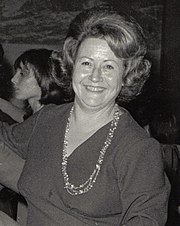Azucena Villaflor's Human Design Chart
3/5 Emotional Manifesting GeneratorArgentine social activist, she was one of the founders of the human rights association called Mothers of the Plaza de Mayo, which looked for desaparecidos (victims of forced disappearance during Argentina’s Dirty War).
Azucena started working at age 16 as a telephone secretary in a home appliances company. There she met Pedro De Vincenti, a labor union delegate. She married De Vicenti in 1949, and they had four children.
On 30 November 1976, eight months after the beginning of the military dictatorship that had named itself “National Reorganization Process”, one of Villaflor’s sons, Néstor, was abducted together with his girlfriend Raquel Mangin. Villaflor started searching for them through the Ministry of Interior and sought support from the military vicar Adolfo Tortolo (though they could only speak with his secretary, Emilio Grasselli). During this search, she met other women also looking for missing relatives.
After six months of fruitless inquiry, Villaflor decided to start a series of demonstrations in order to take her case public. On 30 April 1977, she and thirteen other mothers, including María Adela Gard de Antokoletz, went to Plaza de Mayo in central Buenos Aires, in front of the Casa Rosada government palace, chosen by Villaflor because it was a politically significant spot in the history of Argentina. They decided to march around the Plaza, since the police had ordered them to “circulate”, in the sense of not staying. The first march was on a Saturday, and not very visible; the second one took place on a Friday, and from then on, they settled on Thursdays, at about 3:30 p.m. (this schedule is still kept at present).
That same year, on 10 December, (International Human Rights Day), the Mothers published a newspaper advertisement with the names of their “disappeared” children. That night, Azucena Villaflor was taken by armed force from her home in Villa Dominico, Avellaneda, Buenos Aires. She is reported to have been detained in the concentration camp of the Navy Mechanics School (ESMA), which was run by Alfredo Astiz at that time.
It was not until 2003 that exhumations by the Argentine Forensic Anthropology Team (Equipo Argentino de Antropología Forense, EAAF, known also for having found and identified Che Guevara’s corpse in Bolivia) identified the bodies of five women who had disappeared in 1977: Villaflor, Esther Ballestrino, María Ponce de Bianco, Angela Auad, and Sister Léonie Duquet. The bodies showed fractures consistent with a fall and impact against a solid surface, which confirmed the hypothesis that the prisoners had been taken in one of the many “death flights” (vuelos de la muerte) recounted by former naval officer Adolfo Scilingo. In these flights, prisoners were drugged, stripped naked and flung out of aircraft flying over the ocean.
Villaflor’s remains were cremated and her ashes were buried at the foot of the May Pyramid in the center of the Plaza de Mayo, on 8 December 2005, at the end of the 25th Annual Resistance March of the Mothers. Her surviving children chose the place; her daughter Cecilia said it was because “Here [at the Plaza] is where my mother was born to public life and here she must stay forever. She must stay for everyone”.
A biography of Azucena Villaflor was written by historian Enrique Arrosagaray in 1997 and there is a street with her name.
Link to Wikipedia biography
Discover More Famous People
Browse and analyze over 55,000 public figures and celebrities.
Ra Uru Hu
5/1 Manifestor
Martha Stewart
4/6 Manifestor
David Lynch
4/6 Generator
Barack Obama
6/2 Projector
Steve Jobs
6/3 Generator
Vladimir Putin
5/1 Manifestor
Kim Kardashian
3/5 Generator
Michael Jackson
1/3 Projector
Marilyn Monroe
6/2 Projector
Ariana Grande
2/4 Projector
Oprah Winfrey
2/4 Generator
Johnny Depp
2/4 ManifestorWhat is HumanDesign.ai and how does it work?
Curious what makes Azucena Villaflor tick? HumanDesign.ai instantly maps their exact birth data into a fully interactive clickable bodygraph chart, letting you hover or tap every center, channel, and gate for plain-language explanations. Bella, the platform’s built-in AI guide, adds context in real time, translating complex mechanics into everyday insights so you can see how Azucena Villaflor’s strengths, challenges, and life themes play out on-screen.
The same tools are waiting for you. Generate your own Human Design Chart in seconds, open a library of 2000+ suggested questions, and chat with Bella as often as you like to decode your design, daily transits, and even relationship dynamics.
Want to compare energies? Save unlimited charts for friends, family, or clients, then ask Bella to reveal compatibilities, composite patterns, or coaching tips, all in one conversation thread.
Start free with core features, or unlock our Personal and Pro plans for deeper dives: unlimited Q&A, celebrity chart search spanning 55,000+ public figures, white-label PDF reports, branded content generation, and a professional profile with built-in booking for practitioners. Whether you’re exploring your own potential or guiding others, HumanDesign.ai delivers an ever-expanding toolbox of AI-powered insights—no spreadsheets, no jargon, just clarity at your fingertips.
Ready to see yours? Signup for FREE today!

